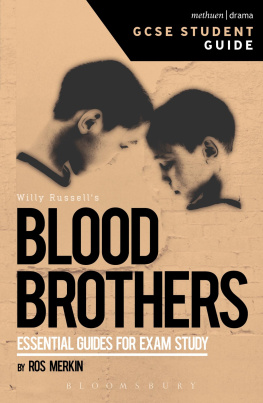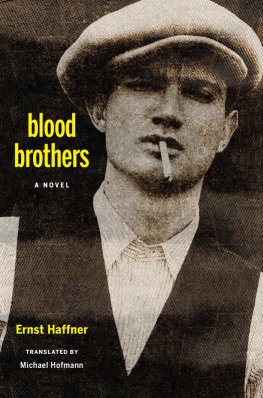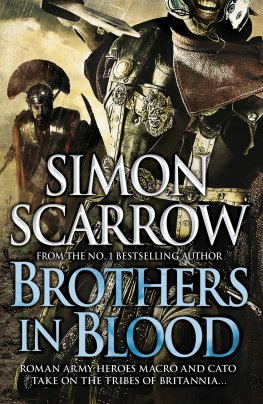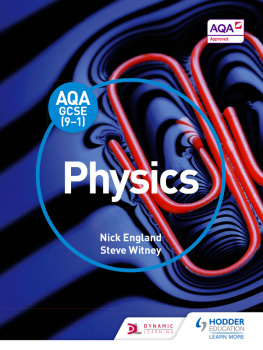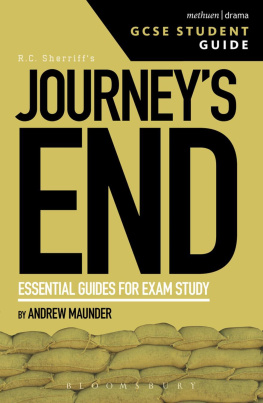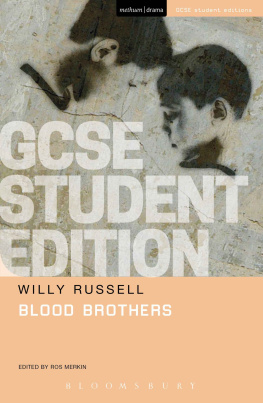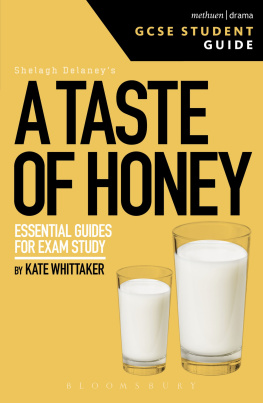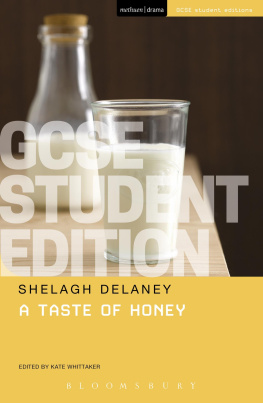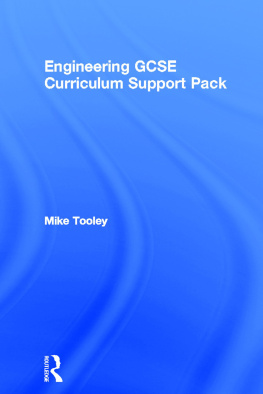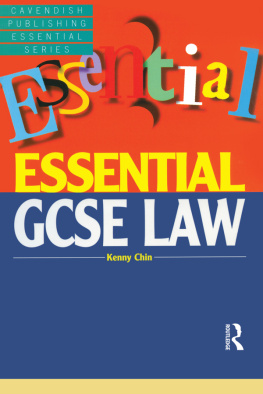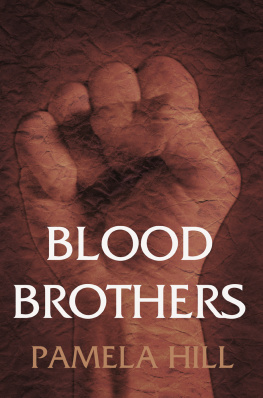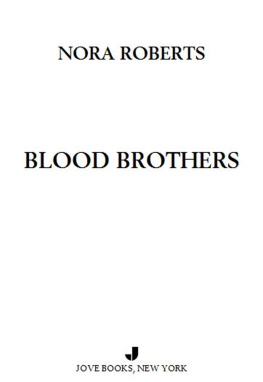Ros Merkin - Blood Brothers GCSE Student Guide
Here you can read online Ros Merkin - Blood Brothers GCSE Student Guide full text of the book (entire story) in english for free. Download pdf and epub, get meaning, cover and reviews about this ebook. year: 2016, publisher: Bloomsbury, genre: Children. Description of the work, (preface) as well as reviews are available. Best literature library LitArk.com created for fans of good reading and offers a wide selection of genres:
Romance novel
Science fiction
Adventure
Detective
Science
History
Home and family
Prose
Art
Politics
Computer
Non-fiction
Religion
Business
Children
Humor
Choose a favorite category and find really read worthwhile books. Enjoy immersion in the world of imagination, feel the emotions of the characters or learn something new for yourself, make an fascinating discovery.
- Book:Blood Brothers GCSE Student Guide
- Author:
- Publisher:Bloomsbury
- Genre:
- Year:2016
- Rating:3 / 5
- Favourites:Add to favourites
- Your mark:
- 60
- 1
- 2
- 3
- 4
- 5
Blood Brothers GCSE Student Guide: summary, description and annotation
We offer to read an annotation, description, summary or preface (depends on what the author of the book "Blood Brothers GCSE Student Guide" wrote himself). If you haven't found the necessary information about the book — write in the comments, we will try to find it.
Blood Brothers GCSE Student Guide — read online for free the complete book (whole text) full work
Below is the text of the book, divided by pages. System saving the place of the last page read, allows you to conveniently read the book "Blood Brothers GCSE Student Guide" online for free, without having to search again every time where you left off. Put a bookmark, and you can go to the page where you finished reading at any time.
Font size:
Interval:
Bookmark:
Methuen Drama publications for GCSE students
Available and forthcoming
Willy Russells Blood Brothers
Simon Stephenss The Curious Incident of the Dog in the Night-Time
Charlotte Keatleys My Mother Said I Never Should
Shelagh Delaneys A Taste of Honey
Willy Russells Blood Brothers by Ros Merkin
Simon Stephenss The Curious Incident of the Dog in the Night-Time by Jacqueline Bolton
Dennis Kellys DNA by Maggie Inchley
Alan Bennetts The History Boys by Steve Nicholson
J. B. Priestleys An Inspector Calls by Philip Roberts
R. C. Sherriffs Journeys End by Andrew Maunder
Charlotte Keatleys My Mother Said I Never Should by Sophie Bush
Shelagh Delaneys A Taste of Honey by Kate Whittaker

Reading a play is a strange thing to do mostly because a play text (the book you hold in your hands), unlike a novel, is not a finished thing. Instead it functions as a blueprint for a performance, a set of instructions for directors and actors and designers to create a performance for an audience to watch and listen to. When you are reading a play you are being asked to use your imagination, to see how a character might look and sound and move, to picture the places and spaces they might inhabit on a stage. The writer does, of course, give you lots and lots of clues and your job in reading is to try and work out how these might all work in practice and also to think about what is happening in-between the lines. Dont forget that if you are in a theatre watching a play, even when they are not speaking, the actors playing the characters are still visible to an audience. Something is still happening.
The information comes in two ways. There is the dialogue or what characters say to each other. There are also the stage directions. These might give you information on how the lines are to be spoken or what a character is doing or where a scene is set. The temptation when reading is to skip over these bits (which in a script are usually in italics) to concentrate on and prioritize what the characters are saying. This means you would miss important moments in the play. For example, in Blood Brothers, you would miss the moment where Mrs Johnstone agrees to allow Mrs Lyons to have one of the twins. She never says yes. She simply nods (38). Or, later, you would miss Mickey battling to stop taking his tablets, as during the song Light Romance, the stage directions tell us
Throughout the following chorus we see MICKEY at work. We see him go to take his pills. We see him make the effort of not taking them. We see the strain of this upon him but see that he is determined. (130131)
So, the stage directions are important both in terms of plot (what happens) but also in terms of character and you cannot afford to miss either.
If you bear in mind when you are reading that while a book tells us a story, a piece of theatre (which is what a play text is destined to be) shows us a story or re-presents it in front of us, this will help remind you to think about what you might be hearing and seeing. After all, the two words we use for people who go to the theatre (audience and spectator) come from words that mean to listen and to watch. The best way to really understand a play is to act it out. It might not be possible in your school, although even the tiniest space will be enough to try things out. If you cannot act the play out, then you might have to make do with reading it aloud, in which case it is useful to have someone reading the stage directions and to discuss what sort of space each scene is happening in.
Think about the title of the play and make a list of all the expectations you have about the play from the title.
Russell presents us with two problems that can make reading the play difficult. Firstly, the play is divided into two acts but whilst there are clearly different scenes, these are not marked in the script as they are in many plays. He has obviously written like this for a reason; it makes the narrative a seamless, inevitable whole that moves relentlessly to the conclusion, but it can make it hard to follow. When she is directing, Glen Walford breaks the play into eighty-two units (or sections). Whilst that number of sections might make things just as confusing, it is useful to think about how you might break the play down into parts to help you study the text. What follows uses the ages of the twins as an organizing device. Secondly, he provides no specific dates. There are some clues in the text, for example, the mention of pounds, shillings and pence (decimalization happened in 1971) and he has said that when the narrator talks about today near the end of the play, that relates to the time of the plays first production. Whilst it is hard to be very specific about dates, it is possible to identify which decade each section takes place in.
Time: 1950s (including a moment in the 1980s)
The play starts at the end, the outline of two bodies marked out on the stage. This means the audience know how it all ends before it has even started, suggesting a fatalism (it will be like this and nothing can change it) and allowing them to concentrate on HOW and WHY it happens rather than WHAT happens. Mrs Johnstone is introduced. She looks old but in the past she danced and was lovelier (and sexier) than Marilyn Monroe. Then her husband walked out on her to dance with someone else, leaving seven children and one more on the way. A sympathy is set up with her plight and two key motifs (dancing and Marilyn Monroe) are introduced.
Time: Late 1950s/early 1960s
Mrs Johnstone cannot even dream of happiness without real life getting in the way and the milkman demanding payment interrupts her reminiscences. She has not got enough money to pay him. From offstage, the children complain and alone onstage Mrs Johnstone tries to appease them. However, there is a promise that things will get better. She has a new job and will be able to feed them. Arriving for her first day at work, the play juxtaposes Mrs Lyons and Mrs Johnstone putting the two characters next to each other to emphasize the differences between them; Mrs Lyons has new shoes but cannot have children and Mrs Johnstone has a duster and a brush and cannot stop having children. It also introduces the theme of superstition as Mrs Lyons puts her new shoes on the table, the moment underlined by the narrator.
Shocked to find out she is having twins, Mrs Johnstones hopes that she was getting straight are dashed but Mrs Lyons forms a plan to help them both. She offers to take one of the babies, and, before Mrs Johnstone has even agreed, is stuffing a cushion under her dress to simulate a pregnancy and planning what to tell her husband. Mrs Johnstone nods her agreement as she realizes that the child will have everything. She can see Mrs Lyons is desperate and is promised she will be able to see the child every day when she comes to work. Mrs Lyons insists that it must be a binding agreement and makes Mrs Johnstone swear on the Bible. Once again, the narrator adds to the tension and for the first time we hear a phrase that will recur: a debt is a debt and must be paid (40). The optimism at the start has evaporated and with the birth of the babies there is little to celebrate.
Font size:
Interval:
Bookmark:
Similar books «Blood Brothers GCSE Student Guide»
Look at similar books to Blood Brothers GCSE Student Guide. We have selected literature similar in name and meaning in the hope of providing readers with more options to find new, interesting, not yet read works.
Discussion, reviews of the book Blood Brothers GCSE Student Guide and just readers' own opinions. Leave your comments, write what you think about the work, its meaning or the main characters. Specify what exactly you liked and what you didn't like, and why you think so.

